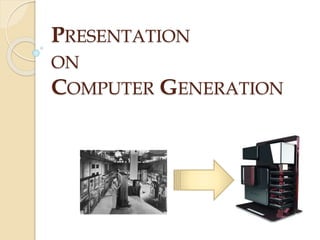
Presentation generation of coputer
- 1. PRESENTATION ON COMPUTER GENERATION
- 2. COMPUTER GENERATION Computer has become a part of our life. Today along with calculations, their work area is very wide-supermarket scaneners scan and calculate our grocery bill and also keep store inventory, automatic teller machines (atms) help us in banking transaction. How the technology has developed and what its future course is. To understand this first we should know about the different generation of computers.
- 3. FIRST-GENERATION COMPUTER (1945-1956) First-generation computers used vacuum tubes and values as their basic electronic component. They were extremely large in size and reliable. The language used for storing and processing data was machine language. Some of the first-generation computers are: ENIAC (electronic numerical integrator and calculator) – it was built in 1946 at the university of PENNSYLVANIA, U S A by JOHN ECKERT and JOHN MAUCHLY. EDVAC (electronic discrete variable automatic computer) – developed in 1950 EDSAC (electronic delay storage automatic computer) – it was developed by MV WILIKES at Cambridge University in 1949 Univac-I - The Universal Automatic Computer was USA’S first commercially available computer system. It was delivered in 1951 by the ECKERT-MAUCHLY computer corp.
- 4. DISADVANTAGE The disadvantages of the first-generation computers are: 1. They were too bulky. 2. They emitted large amounts of heat because they used lots of vacuum tubes 3. AIR conditioning was required. 4. They were prone to frequent failure that’s why they were unreliable. 5. They were not portable.
- 5. SECOND-GENERATION COMPUTERS (1956-1963) In the generation of computers, transistors were used in place of vacuum tubes. Transistors are more compact than vacuum tubes as they are made up of semiconductors. They are also more durable than vacuum tubes. Programming languages some of the computers of the second generation are: IBM 1620 – Its size was used smaller as compared to the first-generation computers and it was used mostly for scientific purpose. IBM 1401- IT was used for was business application. CDC 3600- IT was used for scientific purpose.
- 6. ADVANTAGES The advantages that the second-generation computers had over the generation computers are: They were smaller as compared to first-generation computers. They generated less heat. They took comparatively less computers time. They were less prone to failure. DISADVANTAGES The disadvantages that second generation computer had over the first generation commuter are: They required Air Conditioning. Frequent maintenance was required. They were difficult and quite expensive
- 7. THIRD GENERATION COMPUTER (1964 – 1971) In the third generation of computers integrated circuits (ICs) began to be used. These ICs were called chips. These ICs are more compact than a transistor. Single ICs has many transistors, registers and capacitors, placed on a single thin of silicon. So the computer built of such components became smaller. Some of the computers developed during this period were : IBM- 360- Developed by IBM in 1964. PDP – 8 -Developed by DEC in 1965. PDP- 11 - Developed by DEC IN 1970. CRA 1 - Developed by CRAY research in 1974. VAX - Developed by DEC 1978.
- 8. HIGHT-LEVEL language such as BASIC (Beginners all-purpose symbolic instruction code) were developed during this period. ADVANTAGES THE advantages that the third-generated computers had over the second-generation computers were: 1.They were smaller in size as compared to the second-generation computers. 2. They generated less heat. 3. They reduced computational time. 4. They involved low maintenance cost. 5. They were easily portable. 6. They were comparatively cheaper.
- 9. FOURTH GENERATION COMPUTER (1971 ONWARDS) Fourth-generation computers used very large integration (VLSI) technology. After the induction of integrated circuits, computers could only get small in size, since hundreds of computers could fit onto one chip. By the 1890s, the use of VLSI technology had squeezed hundreds of thousands of computers onto a single chip. Ultra-large scale integration (ULSI) increased that number to millions. This also helped decrease the price of computers are IBM-PC, Apple macintosh, sun SPARC station etc.
- 10. ADVANTAGES THEY ADVANTAGES OF FOURTH GENERATION COMPUTERS OVER THIRD-GENERATION COMPUTERS ARE: They were cheaper. They had a larger memory and high functional speed. They consumed less power. They generated a negligible amount of heat.
- 11. TODAY’S COMPUTER Is classified as fourth generation computers. faster, more powerful, tremendous data storage and processing capacity New brands and models would come out the market almost every other month. Many clones or imitations of the IBM have become even more powerful and a lot cheaper. Computers became more affordable Computers can now be found in homes, schools, offices etc. There has been a tremendous improvement in software technology Different software applications to choose from: word processing, spreadsheets, database management, games and entertainment. Computer subjects are now being offered not just to college students but even to high school and elementary. Computers are now used as an aid in teaching math, science etc.
- 12. Presented By - Jayesh Modi STUDENT OF GUJARATI INNOVATIVE COLLEGE, INDORE ,MP
